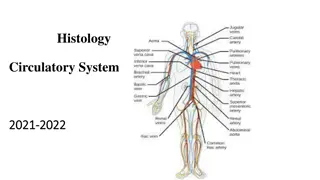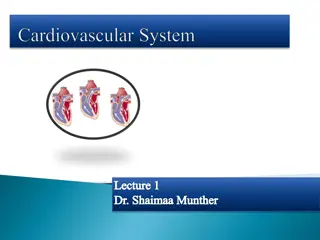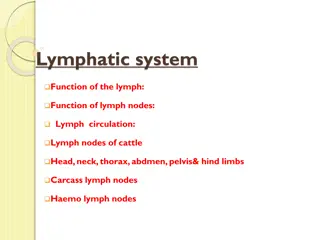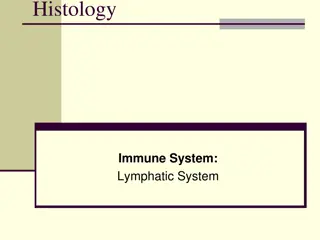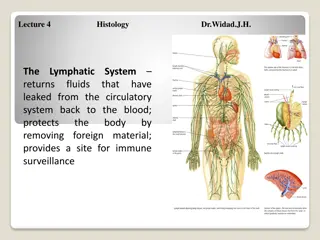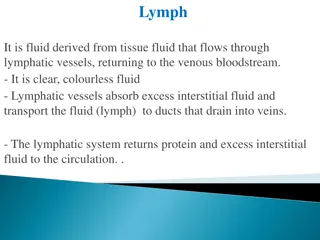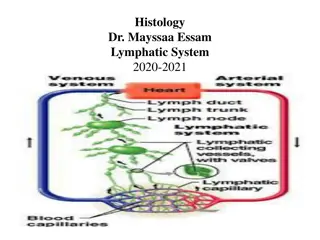
Lymphatic System: Functions and Anatomy
Explore the intricacies of the lymphatic system, a vital network responsible for fluid balance, absorption, and immune defense. Learn about its functions, how it works, and why lymph nodes swell. Dive into the anatomy and importance of this system for overall health.
Uploaded on | 1 Views
Download Presentation

Please find below an Image/Link to download the presentation.
The content on the website is provided AS IS for your information and personal use only. It may not be sold, licensed, or shared on other websites without obtaining consent from the author. If you encounter any issues during the download, it is possible that the publisher has removed the file from their server.
You are allowed to download the files provided on this website for personal or commercial use, subject to the condition that they are used lawfully. All files are the property of their respective owners.
The content on the website is provided AS IS for your information and personal use only. It may not be sold, licensed, or shared on other websites without obtaining consent from the author.
E N D
Presentation Transcript
StudyMafia.Org Lymphatic System Submitted To: Studymafia.org Studymafia.org Submitted By:
Table Contents Definition Introduction Functions of Lymphatic System How it Works? Anatomy of Lymphatic System Why do Lymph nodes Swell? Lymphoma Conclusion 2
Definition The Lymphatic System is an extensive network of vessels, nodes, and ducts that pass through almost all bodily tissues. It allows the circulation of a fluid called lymph through the body in a similar way to blood. 3
Introduction The lymphatic system is a network of vessels, nodes, and ducts that collect and circulate excess fluid in the body. There are 500 600 lymph nodes throughout the body. These nodes swell in response to infection due to a buildup of lymph fluid, bacteria, or other organisms and immune system cells. The lymphatic system is part of the immune system. It also maintains fluid balance and plays a role in absorbing fats and fat-soluble nutrients. 4
Functions of Lymphatic System Fluid balance The lymphatic system returns excess fluid and proteins from the tissues that cannot return through the blood vessels. The fluid often collects in the tiny spaces surrounding cells, known as the interstitial spaces. Small lymph capillaries connect these spaces to the lymphatic system. Around 90% of the plasma that reaches tissues from the arterial blood capillaries returns through the venous capillaries and veins. 5
Functions of Lymphatic System Absorption The lymphatic system plays a key role in intestinal function. It assists in transporting fat, fighting infections, and removing excess fluid. Part of the gut membrane in the small intestine contains tiny finger-like protrusions called villi. Each villus contains tiny lymph capillaries, known as lacteals. These absorb fats and fat-soluble vitamins to form a milky white fluid called chyle. 6
Functions of Lymphatic System The immune system The third function of lymph nodes is to defend the body from exposure to potentially hazardous microorganisms, such as infections. The body s first line of defense involves: Physical barriers, such as the skin Toxic barriers, such as the acidic contents of the stomach Friendly bacteria in the body 7
How it Works? The lymphatic system produces white blood cells called lymphocytes. There are two types of lymphocytes: T cells and B cells. They both travel through the lymphatic system. As they reach the lymph nodes, they come into contact with viruses, bacteria, and foreign particles in the lymph fluid. 8
How it Works? They can also produce antibodies from memory if they have already encountered the specific pathogen in the past. The lymphatic system and the action of lymphocytes form part of the body s adaptive immune response. These are highly specific and long lasting responses to particular pathogens. 9
Anatomy of Lymphatic System The lymphatic system consists of lymph vessels, ducts, nodes, and other tissues throughout the body. Lymphatic vessels collect interstitial fluid and transport it to lymph nodes. These nodes filter out damaged cells, bacteria, and other foreign bodies. Once this fluid passes out of the lymph nodes, it travels to larger vessels and eventually lymph ducts, which converge in the thoracic duct at the base of the neck. The thoracic duct returns filtered lymph into the bloodstream. 11
Anatomy of Lymphatic System Thymus gland: The thymus gland is a lymphatic organ and an endocrine gland behind the sternum. It secretes hormones and is crucial to the production, maturation, and differentiation of immune T cells. Tonsils: The tonsils produce lymphocytes and antibodies. They can help protect againstTrusted Source inhaled and swallowed foreign bodies. 12
Anatomy of Lymphatic System Spleen: The spleen is not part of the connected lymphatic system, but it is lymphoid tissue. It produces white blood cells and filters the blood to remove microbes as well as old and damaged red blood cells and platelets. Bone marrow: Bone marrow is not lymphatic tissue but is part of the lymphatic system because it is here that the B cell lymphocytes of the immune system mature. 13
Why do lymph nodes swell? Lymph nodes can swell for two common reasons: a reaction to an infection and direct infection of the lymph nodes. In the former, the lymph nodes react when coming into contact with foreign materials from infected tissue. Direct infection can cause lymphadenitis. In this, infection causes inflammation in the lymph nodes, and a person will require antibiotic treatment. 14
Why do lymph nodes swell? Most people who have swollen glands with a cold or flu do not need to contact a doctor. However, a person should seek medical advice if: Lymph nodes stay swollen for longer than 2 weeks A swollen lymph node feels hard or fixed in place Swelling accompanies a fever, night sweats, or unexplained weight loss 15
Why do lymph nodes swell? Glandular fever: Also known as infectious mononucleosis, or mono, this is a viral infection that can cause long lasting swelling, a sore throat, and fatigue. Tonsillitis: This is more common in children than in adults. It occurs when the lymph nodes at the back of the mouth are fighting an infection, usually viral but sometimes bacterial. 16
Lymphoma Cancer that starts in the lymphatic system is known as lymphoma. It is the most serious lymphatic disease. Hodgkin lymphoma affects B lymphocytes, a type of white blood cell. People with Hodgkin lymphoma will have a certain type of lymphocyte present in their blood called Reed- Sternberg cells. Non-Hodgkin lymphoma refers to types that do not involve these cells. It most commonly affects lymph nodes in the upper part of the body, such as the neck, chest, and under the arms. 17
Conclusion The lymphatic system drains excess fluid that accumulates in bodily tissue, filters out foreign bodies, and transports it back into the bloodstream. The lymphatic system is a collection of vessels, nodes, and ducts that span most of the body. Failures of the lymphatic system can cause swelling, venous dysfunction, and life threatening complications. 19
References Google.com Wikipedia.org Studymafia.org Slidespanda.com
Thanks To StudyMafia.org







